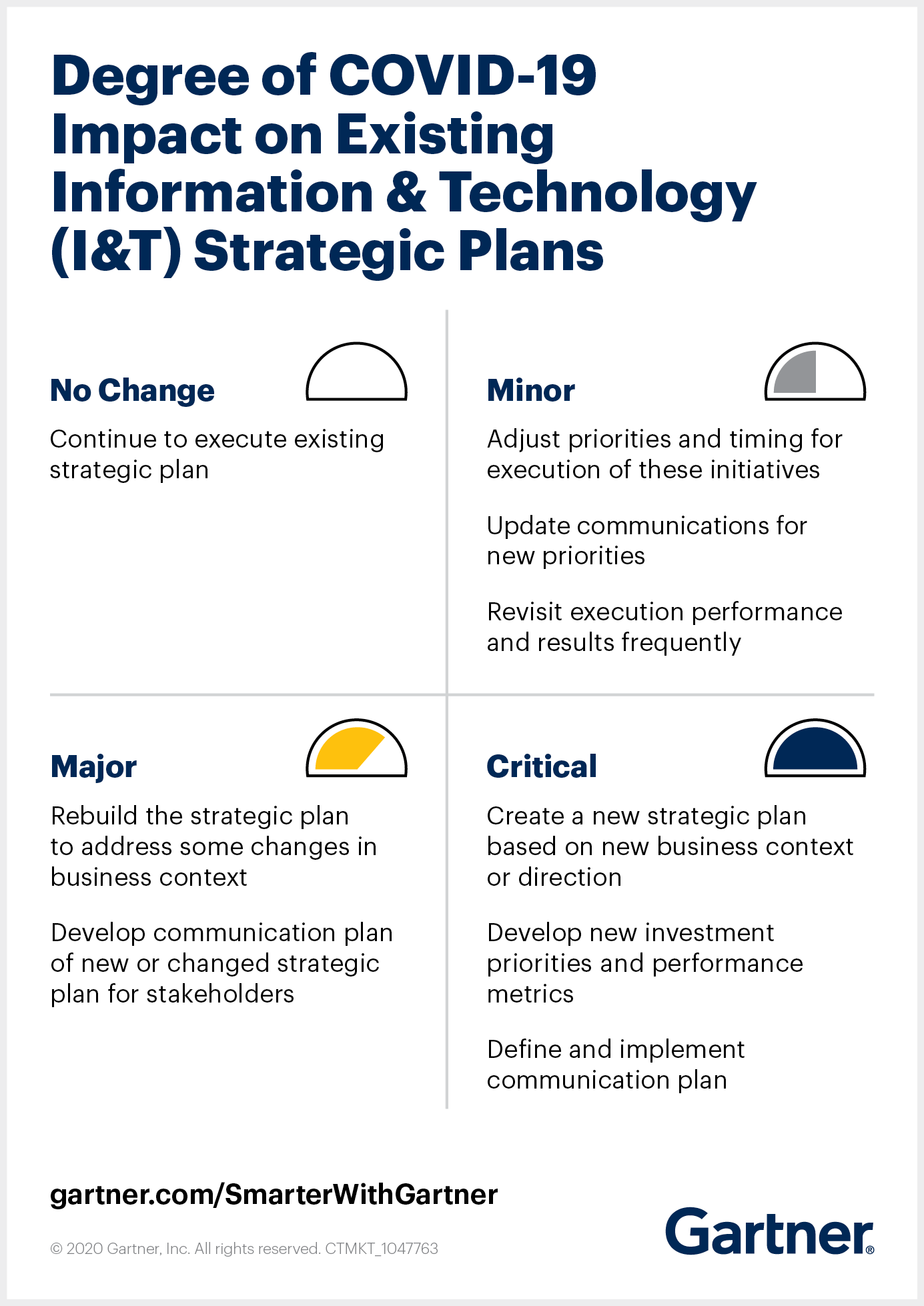Few strategies and strategic plans, if any, will survive COVID-19 unchanged. The pandemic recovery has prompted a reset in business strategy, and CIOs and other technology leaders have to determine whether, and by how much, to rethink the IT strategic plan and recalibrate execution.
Given today’s fast-changing conditions, senior business leaders are increasingly using adaptive strategies to (re)define the long-term direction of the enterprise. Functional strategic plans follow, with a roadmap of initiatives and investments required to achieve the objectives defined in the strategy. For most CIOs, it’s time to consider recalibrating those strategic plans for IT.
“First, you need to determine the impact of strategy shifts on the existing IT strategic plan,” says Joanne Kopcho, VP Analyst, Gartner. “Only once you know whether the impact is negligible, minor, major or critical can you determine whether you need to refresh or update the plan, or overhaul it completely.”
[swg_ad id=”37208″]
How far has and will the business strategy shift?
In their initial response to the pandemic, many enterprises had to halt certain activities or deploy temporary solutions on very short timelines. As organizations move past response and into recovery and renewal, senior leaders are deciding whether to reverse those initial changes or reinforce them over the long term.
Many pandemic-driven changes are unlikely to reverse. A Gartner Board of Directors survey showed that seven out of 10 board directors believe the COVID-19 impact has already accelerated digital business initiatives. This acceleration is likely to have an ongoing and significant impact on in-flight IT strategic plans.
Even in these volatile conditions, senior leaders need a formal long-term strategy that articulates what the enterprise will do to compete and succeed in its chosen markets or, for the public sector, what the agency will do to achieve its mission. The question for functional leaders is how much those new strategies impact existing strategic plans.
Initiate, update or refresh the IT strategic plan
By using the Gartner checklist approach, CIOs can determine the extent to which strategic actions, principles and metrics have changed in response to the crisis. The checklist contains a series of questions to guide CIOs, as they rethink or revisit changes to existing strategic plans, such as:
- During our initial response to the crisis, did we build or acquire any new or temporary capabilities that we no longer need — or that need to be made permanent?
- Have there been changes to the business objectives, goals or strategies that need to be reflected in the strategic principles? Have changes affected the business model or markets?
- Has change occurred that is impacting the balance of cost, risk and value within the strategic plan?
As CIOs complete the checklist, the responses help to determine the degree of recalibration required, based on these impacts:
- Critical change could require a new IT strategic plan built from scratch.
- Major change likely requires key components of the plan to be rebuilt.
- Minor change means adjusting execution within the existing plan.
- No change means continuing to execute the existing plan as originally envisaged.
Recalibrate IT strategic plans for today and tomorrow
The extent of changes and recalibration for the IT strategic plan can vary by organization. Additional activities to recalibrate may require one or all of these actions:
- Reprioritize and address conflicts, e.g., determine which initiatives to stop, pause or start.
- Reset engagement and communication, e.g., articulate new priorities across the organization.
- Validate strategic plan metrics and triggers, e.g., change dashboards and reporting practices to reflect new or changed roadmaps.
CIOs should establish checkpoints to continue recalibrating over time as conditions, digital trends and objectives evolve. The accelerated-digital trend adds unique demands on IT strategic plans. Under the microscope, for example, will be the composable technology foundation that’s needed to balance efficiency with resilience and the need for any-scale operations that can spin up and down with demand.
Going forward, for example, organizations should be applying digital business acceleration to a range of activities, from meeting the needs of the “everything customer” (who demands both personalization and privacy) to building an adaptable workforce equipped with the skills, processes, information and autonomy to flex in the face of disruption.
And ultimately, the IT strategic plan must be able to flex not only with evolving strategy, but to accommodate scenario plans and totally unforeseen circumstances.
![]()
The post Decide Now How Much to Recalibrate IT Strategic Plans appeared first on Smarter With Gartner.

